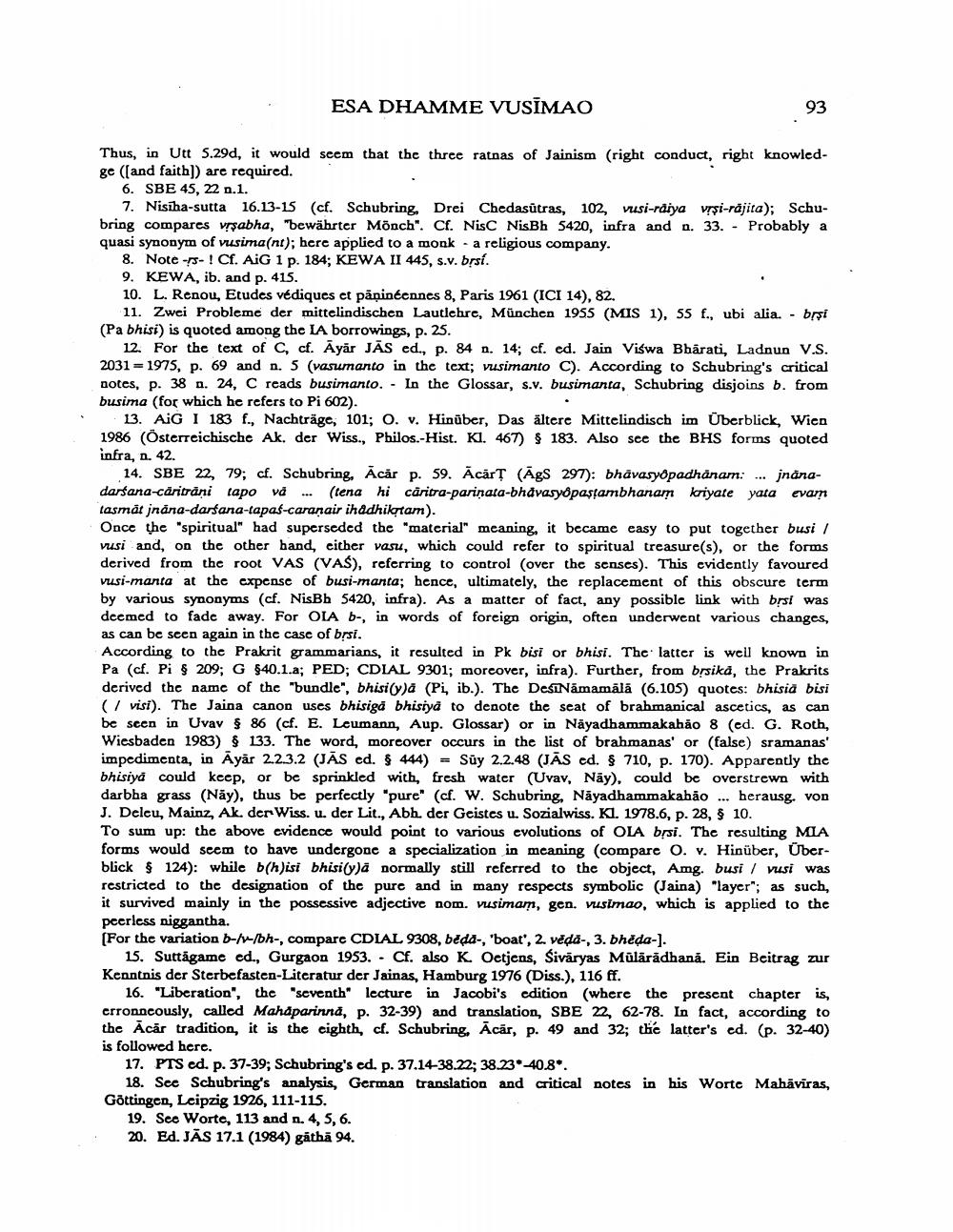________________
ESA DHAMME VUSIMAO
93
Thus, in Utt 5.29d, it would seem that the three ratnas of Jainism (right conduct, right knowledge (and faith)) are required.
6. SBE 45, 22 n.1.
7. Nisiha-sutta 16.13-15 (cf. Schubring. Drei Chedasūtras, 102, vusi-raiya vrsi-räjita); Schubring compares vrsabha, "bewährter Mönch". Cf. NisC NisBh 5420, infra and n. 33. - Probably a quasi synonym of usima(nt); here applied to a monk - a religious company.
8. Note -r- ! Cf. AiG 1 p. 184; KEWA II 445, s.v. brsi. 9. KEWA, ib. and p. 415. 10. L. Renou, Etudes védiques et pāņinéennes 8, Paris 1961 (ICI 14), 82.
11. Zwei Probleme der mittelindischen Lautlehre, München 1955 (MIS 1), 55 f., ubi alia. - brși (Pa bhisi) is quoted among the IA borrowings, p. 25.
12. For the text of c, cf. Āyar JĀS ed., p. 84 n. 14; cf. ed. Jain Viswa Bbärati, Ladnun V.S. 2031 = 1975, p. 69 and n. 5 (vasumanto in the text; vusimanto C). According to Schubring's critical notes, p. 38 a. 24, C reads busimanto. - In the Glossar, s.v. busimanta, Schubring disjoins b. from busima (for which he refers to Pi 602).
13. ANG I 183 f., Nachträge, 101; O. v. Hinüber, Das ältere Mittelindisch im Überblick, Wien 1986 (Österreichische Ak. der Wiss., Philos. Hist. Kl. 467) $ 183. Also see the BHS forms quoted infra, n. 42.
14. SBE 22, 79; cf. Schubring, Acar p. 59. Acar? (AgS 297): bhāvasyopadhanam: ... jnanadarśana-caritrani tapo và ... (tena hi caritra-pariņata-bhavasyopastambhanam kriyate yata evam tasmät jnana-darsana-lapas-caranair inadhikytam). Once the "spiritual" had superseded the "material" meaning, it became easy to put together busi/ vusi and, on the other hand, either vasu, which could refer to spiritual treasure(s), or the forms derived from the root VAS (VAS), referring to control (over the senses). This evidently favoured vusi-manta at the expense of busi-manta; hence, ultimately, the replacement of this obscure term by various synonyms (cf. NisBb 5420, infra). As a matter of fact, any possible link with brsi was deemed to fade away. For OIA b-, in words of foreign origin, often underwent various changes, as can be seen again in the case of brsi. According to the Prakrit grammarians, it resulted in Pk bisi or bhisi. The latter is well known in Pa (cf. Pi $ 209; G $40.1.a; PED; CDIAL 9301; moreover, infra). Further, from brsika, the Prakrits derived the name of the "bundle", bhisi ya (Pi, ib.). The DesiNamamälä (6.105) quotes: bhisia bisi (1 visi). The Jaina canon uses bhisiga bhisiya to denote the seat of brahmanical ascetics, as can be seen in Uvay $ 86 (cf. E. Leumann, Aup. Glossar) or in Nāyadhammakabão 8 (ed. G. Roth, Wiesbaden 1983) $ 133. The word, moreover occurs in the list of brahmanas' or (false) sramanas impedimenta, in Ayar 2.2.3.2 (JAS ed. $ 444) = Sūy 2.2.48 (JAS ed. $ 710, p. 170). Apparently the bhisiya could keep, or be sprinkled with, fresh water (Uvav, Näy). could be overstrewn with darbha grass (Näy), thus be perfectly "pure" (cf. W. Schubring, Nāyadhammakabão ... herausg. von J. Delcu, Mainz, Ak. der Wiss. u. der Lit., Abh. der Geistes u. Sozialwiss. Kl. 1978.6, p. 28, $ 10. To sum up: the above evidence would point to various evolutions of OLA brsi. The resulting MIA forms would seem to have undergone a specialization in meaning compare O. v. Hinüber, Überblick $124): while b(h)isi bhisi(y)ā normally still referred to the object, Amg. busi / vusi was restricted to the designation of the pure and in many respects symbolic (Jaina) "layer"; as such, it survived mainly in the possessive adjective nom. vusimam, gen. vusimao, which is applied to the peerless niggantha. (For the variation b-lv-bh-, compare CDIAL 9308, beda-, 'boat', 2. veda-, 3. bheda-).
15. Suttagame ed., Gurgaon 1953. - Cf. also K. Oetjens, Siväryas Muläradhana. Ein Beitrag zur Kenntnis der Sterbefasten-Literatur der Jainas, Hamburg 1976 (Diss.), 116 ff.
16. "Liberation", the "seventh" lecture in Jacobi's edition (where the present chapter is, crronncously, called Mahaparinna, p. 32-39) and translation, SBE 22, 62-78. In fact, according to the Acar tradition, it is the eighth, cf. Schubring, Ācār, p. 49 and 32; the latter's ed. (p. 32-40) is followed here.
17. PTS ed. p. 37-39; Schubring's ed. p. 37.14-38.22; 38.23-40.8*.
18. Sec Schubring's analysis, German translation and critical notes in his Worte Mahāvīras, Göttingen, Leipzig 1926, 111-115.
19. See Worte, 113 and n. 4,5,6. 20. Ed. JĀS 17.1 (1984) gathā 94.




